Grand Challenges
We are focused on solving problems. How do we prevent, treat, and cure diseases? How do we address the many environmental issues we face? What knowledge can be generated to promote healthy and sustainable ecosystems? How do we ensure water and food safety, and provide sustenance for an ever-growing world population?
Teams of Scientists
These kinds of grand challenges are very complex and require a team science approach to problem solving. The BIO5 Institute brings together multifaceted scientific teams that include world-class plant, animal and human bioscientists, engineers, physicians, and computational researchers. Below are some examples of teams working collaboratively to envision and develop bold solutions. See News to read more about our latest research innovations.
Controlling Dust with New Technology

People living in dry climates experience the problems wrought by dry air and blowing dust, which affects everything from respiratory health to cars and other machinery. To address the problem, a team led by engineering assistant professors Dr. Minkyu Kim and Dr. Kwangmin Kim has developed an environmentally safe biocompatible polymer blend keeps the ground damp for more than two months, even when exposed to the open desert air, to aid in dust control. This product is being commercialized through Clean Earth Tech as a new way to control dust in arid environments and places such as mines, construction sites, and subway tunnels. An added feature is that because the new material can be mixed with water, it can be distributed and applied using pre-existing technologies and machinery such as water tank trucks using current spraying techniques.
Project Investigators:
Using Metabolomics to Fight Cervical Cancer

Dr. Melissa Herbst-Kralovetz, associate professor at the College of Medicine - Phoenix, led a team of interdisciplinary researchers in the identification of three compounds that distinguish cervical cancer patients. The team completed a first-of-its-kind study that could aid in the treatment, diagnosis, and prevention of cervical cancer by identifying cervicovaginal metabolic signatures, or “fingerprints,” that distinguish patients with HPV, precancerous cervical conditions and cancer. Through integration of cutting-edge analysis including metabolomics, the team was able to reveal new information about viruses, bacteria, inflammation and disease impact on metabolic signatures. Levels of metabolites often change in response to disease progression, and metabolic fingerprinting has the potential to be used for the development of future diagnostics, preventatives or treatments for cervical cancer.
Project Investigators:
Liquid Biopsy to Fight Cancer
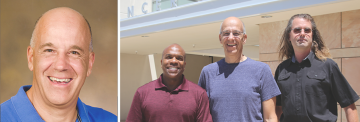
To lower the need for invasive procedures, Dr. Bernard Futscher, professor of pharmacy, and Dr. Lukas Vrba, assistant research scientist at the UArizona Cancer Center, have combined the latest discoveries in epigenetics with new methods in informatics to create a new breed of “liquid biopsy” – a blood test for screening, detecting and monitoring cancers. The technique utilizes the analysis of biological markers within the bloodstream with advanced data-processing to detect and quantify cancer cells. Initial testing and results have revealed promising results with detection of early stage non-small lung cancer. In 2018, the researchers launched the startup, DesertDx, to commercialize the technology and bring the invention to doctors and their patients.
Project Investigators:
Combatting Pain and the Opioid Crisis
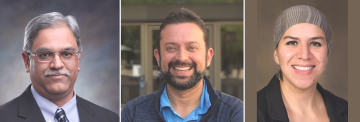
In the past 10 years, the nation’s opioid crisis has skyrocketed. Local startup Regulonix has licensed a newly invented class of non-opioid painkillers that are non-addictive and non-toxic at high doses and more effective than morphine. These inhibitors indirectly regulate voltage-gated sodium Nav1.7 channel via a unique pathway. While chronic pain and opioid misuse and overdose are widely prevalent, the discovery could provide viable options to combat these major public health crises. The company's co-founders and inventors include associate professor of anesthesiology and neuroscience and professor of pharmacology Dr. Rajesh Khanna, assistant professor of pharmacology Dr. May Khanna, and senior research scientist Dr. Vijay Gokhale.
Project Investigators:
Vertical Farming as a Solution to Feeding the Growing Population

Sustainable agriculture is ever more important as global leaders try to answer the question of how to feed a world population approaching 10 billion by mid-century. BIO5 member Dr. Joel Cuello and professor of biosystems engineering Dr. Murat Kacira are looking for answers in the form of vertical farming, which will enable more efficient food production with fewer resources. A vertical farm is an enclosed and highly controlled space consisting of food production in vertically stacked layers. It is intended to consistently optimize productivity in hopes of meeting the growing demand for food. As researchers improve the technology needed to make this concept viable on a large scale, private companies are starting to enter the vertical farming space commercially and will serve as partners to advance a sustainable business model.
Project Investigators:
Lung on a Leaf

Dr. Kenneth Knox, pulmonary medicine specialist, and Dr. Frederic Zenhausern, Director of the Center for Applied NanoBioscience and Medicine, combined knowledge in plant biology, engineering and medicine to create a revolutionary new model to study pulmonary disease called a “lung on a leaf.” Previously, the lab developed an “organ on a chip” that mimics the human gut and can analyze the complex interactions between human cells and the microbial ecosystems of the gut, predicting their effects on health or disease. The idea for “lung on a leaf” stemmed from the use of spinach leaves as a new cancer research model. After noticing the similarities between the branching structures of the leaf scaffold and that of the lung, it became clear that the model would be feasible for in vivo pulmonary studies. This could mean an innovation in testing cell types in order to learn more about lung immunity and lung fibrosis within infections or diseases such as valley fever or sarcoidosis.
Project Investigators:
Heart Graft Provides Alternative for Chronic Heart Failure Patients

UArizona researchers Dr. Steven Goldman, professor of medicine, Dr. Jordan Lancaster, assistant research scientist, and Dr. Jen Watson Koevary, research assistant professor of biomedical engineering, have developed a tissue-engineered, biodegradable heart graft for treating patients with heart failure with Nobel Prize-winning induced pluripotent stem cell technology. The heart graft will be pre-made, cryopreserved and ready for implantation. Ultimately, this technology has the ability to offset the burden of patients needing heart transplant, offering a promising alternative treatment for chronic heart failure patients, with the ability to regenerate function in damaged tissues. The researchers created local startup Avery Therapeutics, Inc., which has licensed the technology. Pre-clinical studies have already shown that the technology, MyCardia™, improves heart function, and the team aims to make the technology the world's first off-the-shelf product for treatment of heart failure.
Project Investigators:
COVID-19 AND BRAIN FUNCTION

A hallmark of COVID-19 is the impairment of respiratory function. However, a fourteenth project will assess the cognitive impact of COVID-19. Funded by Center for Innovation in Brain Science, Dr. Lee Ryan of the College of Science and Dr. Meredith Hay of the College of Medicine are utilizing an existing database of over 50,000 individuals to understand brain-related impacts of the infection.
Project Investigators:
COVID-19 RISK IN WASTEWATER TREATMENT FACILITIES
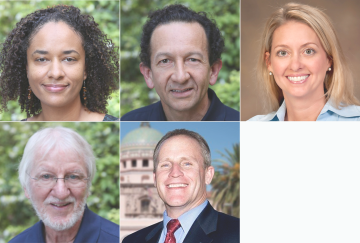
In addition to traveling through droplets in the air generated by a sneeze or cough, the novel coronavirus passes through the feces of infected individuals. These live viruses can become airborne in wastewater treatment plants, posing a threat to facility workers. A team of four researchers at the UArizona Water and Energy Sustainable Technology Center – environmental science assistant research professors Drs. Luisa Ikner and Walter Betancourt, public health professor Dr. Kelly Reynolds and environmental science professor Dr. Ian Pepper – are working with Jeff Prevatt, deputy director of the Pima County Regional Wastewater Reclamation Department, to study the risk of the airborne virus to facility worker health.
Project Investigators:
UNDERSTANDING VULNERABILITY TO COVID-19

In addition to creating COVID-19 databases, UArizona researchers will address public health concerns by exploring relationships between COVID-19, pre-existing health conditions and the environment. Older adults and those with existing critical health conditions seem to be at greater risk for COVID-19. Dr. Janko Nikolich-Žugich, head of the Department of Immunology, and associate professor Dr. Deepta Bhattacharya are teaming up with Dr. Craig Weinkauf, assistant professor in the Department of Surgery, to find out why.
USING GENETICS TO STUDY THE ORIGIN AND SPREAD OF COVID-19 IN SOUTHERN ARIZONA

As of April 2020, only one viral genome had been recorded for Arizona COVID-19 cases. Drs. Michael Worobey and David Baltrus are working to add nearly 40 more genomes to GenBank, a repository curated by the National Institutes of Health. In addition to contributing data, the team is understanding the relationship of the Arizona outbreak to the national epidemic. By comparing viral genomes across the country, the group hopes to determine origin of COVID-19 in Southern Arizona and the number of transmission chains in the area.
CHARACTERIZATION OF CRITICALLY ILL COVID-19 ARIZONAN PATIENTS

Because our understanding of COVID-19 is limited to emerging, highly variable case reports, an interdisciplinary team will produce a database with information on hospitalized COVID-19 patients in our state. Dr. Vignesh Subbian, assistant professor in the College of Engineering, and Dr. Jarrod Moiser of COM-T are compiling patient characteristics and documenting the safety of their care. Through their efforts, they aim to catalog the clinical characteristics and courses of seriously ill COVID-19 patients in Arizona to better understand the relationship of the Arizona outbreak to the national epidemic.
Project Investigators:
CREATING FOUNDATIONS TO UNDERSTAND COVID-19 IN ARIZONA

Drs. Kristen Pogreba-Brown and Kate Ellingson, both assistant professors of public health, public health professor Dr. Elizabeth Jacobs, public health associate professor Dr. Kacey Ernst and Dr. Pamela Garcia-Filion, associate research scientist in the Department of Biomedical Informatics at the University of Arizona College of Medicine – Phoenix, are creating a database to better understand the short- and long-term impacts of COVID-19 in our area. Produced from patient interviews, the database will provide a catalog of acute risk factors and patient symptoms that can be used by all Arizona investigators addressing COVID-19. They are also initiating a long-term study to generate a database that can be used by all Arizona investigators addressing COVID-19.
Project Investigators:
A PATIENT DATABASE TO STUDY LOCAL COVID-19 IMPACT

Some researchers as tackling the COVID-19 pandemic through epidemiological and public health approaches. A team representing medicine, pharmacy and public health are using patient data from Banner – University Medical Center Tucson and area family medicine clinics to create a local COVID-19 database. The team includes Dr. Karen Lutrick, assistant professor in the College of Medicine – Tucson; Dr. Dean Billheimer, professor of public health; and Dr. Brian Erstad, professor of pharmacy. The team hopes this database will provide a useful tool for future COVID-19 UArizona research efforts.
NOVEL COMPOUNDS TO ENHANCE ANTI-COVID-19 ACTIVITY AND SAFETY

Because clinical studies of anti-malarial drugs have provided uncertain evidence regarding their utility in treating COVID-19, a College of Pharmacy team is testing novel inhibitors in treating existing infections. Drs. Wei Wang, Steffan Nawrocki and Jennifer Carew will use the anti-malarial drugs as the foundation for designing similar, yet distinct compounds. By doing so, these experts in drug discovery and viral biology aim to identify new compounds which may prove to be safer and more efficacious.
Project Investigators:
BOOSTING THE IMMUNE SYSTEM TO COMBAT COVID-19

Directly targeting the virus is just one strategy researchers can use to treat COVID-19. Because of the severe gap in knowledge regarding the novel coronavirus, some researchers propose that developing a virus-targeted approach may not be quickly achievable. Dr. Jianqin Lu, assistant professor of pharmacy, is working with Dr. Yin Chen, associate professor, to investigate whether immune system activation can treat COVID-19.
IMPROVING EFFICACY AND MINIMIZING TOXICITY OF ANTI-MALARIAL DRUGS AGAINST COVID-19

Equally important to preventing new infections with the novel coronavirus is treating existing ones. Two anti-malarial drugs, chloroquine and hydroxychloroquine, are currently being investigated as COVID-19 treatments, though their utility and safety is uncertain. College of Pharmacy assistant professor Dr. Jianqin Lu and professor Dr. Xinxin Ding will use nanotechnology to improve the delivery of these drugs. Through this method, they aim to enhance drug efficacy and minimize toxicity.
THE USE OF COPPER IN PREVENTING VIRAL PERSISTENCE

Dr. Koenraad Van Doorslaer, assistant professor in the College of Agriculture and Life Sciences, and Dr. Michael Johnson, assistant professor of immunobiology, are investigating the use of copper compounds in preventing infection with SARS-CoV-2 – the etiological agent behind COVID-19. They are beginning their studies on a related coronavirus. If successful, the team will test successful compounds against the novel COVID-19 virus.
IDENTIFYING POTENTIAL COVID-19 THERAPEUTICS THROUGH IMAGE-BASED SCREENING

In a rapid response to the COVID-19 pandemic, Dr. Curtis Thorne, assistant professor of cellular and molecular medicine, is teaming up with Dr. Koenraad Van Doorslaer, assistant professor in the College of Agriculture and Life Sciences, to identify therapies to prevent and treat infection with SARS-CoV-2. The pair uses image-based screening techniques to identify compounds that may interfere with the ability of the virus to infect and cause long-lasting infections. They are also developing a technique to study the replication of the novel coronavirus and plan to share it with other UArizona researchers studying COVID-19.
UNDERSTANDING THE EVOLUTION OF A VIRUS
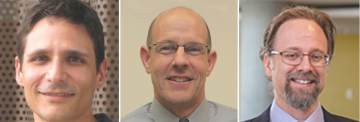
Something about the novel coronavirus has enabled it to expertly infect humans, resulting in the COVID-19 pandemic. Dr. Samuel Campos, associate professor of immunobiology; Dr. Scott Boitano, professor of physiology; and Dr. Ken Knox, professor of medicine, are in search of that special something. The three researchers, representing the College of Medicine – Tucson, will investigate how the evolutionary adaptation of a key viral structure may have enabled this novel strain to cause rapid worldwide disease. Knowledge generated from their work may inform potential prevention and treatment strategies.
The Role That Genetics Plays In Valley Fever

Dr. John Galgiani, director of the University of Arizona Valley Fever Center for Excellence and professor of medicine in the Division of Infectious diseases is doing research under a $2.27 million dollar grant to study the immuno-genetic reasons why some people fall deathly ill after contracting Valley Fever, while others remain relatively unaffected. Dr. Yves Lussier, previous associate director of the BIO5 Institute, and associate vice president and director of the Center for Biomedical Informatics and Biostatistics at the UA Health Science, is a co-investigator on the study specializing in big data and deciphering DNA sequences. Together they’ve determined that a gene mutation could be the reason why some are susceptible to fatal forms of Valley Fever, a novel discovery that will inform the creation of a preventative vaccine.
Project Investigators:
Understanding Obesity’s Effect On Asthma Treatment

Dr. Monica Kraft, department chair and professor of medicine at the UA College of Medicine—Tucson, and Dr. Julie Ledford, assistant professor of medicine, began doing asthma research while Ledford was still a postdoctoral fellow at Duke University. Collaboratively, they have found that those with a higher BMI lack an important protein for people struggling with asthma, called SP-A. SP-A helps to reduce the lungs’ response to environmental irritants, like pollution. In their collective research, they were able to deduce that obese individuals have higher levels of cytokines that activate the immune system and suppress SP-A, thus leaving them with lower levels of this important protein. Without SP-A, asthmatics are unable to fight pathogens, making them more susceptible to lung infections. Along with Tech Launch Arizona, Kraft and Ledford are working to translate their discoveries into a new inhaler therapy that will revolutionize treatments for those with airway diseases.
Project Investigators:
Next Generation Genome Sequencing Aims To Help Doctors Personalize Treatments
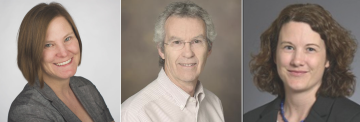
Dr. Bonnie Hurwitz, UA Assistant Professor of Biosystems Engineering and BIO5 fellow, has combined both genomics and computer programming for her research in metagenomics, or the sequencing of whole communities of microorganisms within a sample. The ultimate goal of her work is for doctors to be able to sequence samples from patients to offer quick diagnoses and treatment plans. Her lab has worked collaboratively with BIO5 member Dr. Thomas Doetschman, UA Professor of Cellular and Molecular Medicine and Professor of Cancer Biology, researching colon cancer. Hurwitz also works alongside BIO5 member Dr. Jana U’Ren, UA Assistant Professor of Ecosystem Genomics, in the Environmental Bioinformatics program, which is developing bioinformatics tools to support analyses at all computational levels aimed at answering questions related to the relationship between microbes, their hosts, and the environment.
Project Investigators:
Teaching Computational Methods To Predict Disease
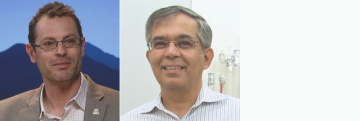
A class called Applied Concepts in Cyberinfrastructure, or ACic, is taught every fall semester at the UA by CyVerse co-principal investigators and BIO5 members Dr. Eric Lyons, Assistant Professor of Plant Sciences in the College of Agriculture and Life Sciences, and Dr. Nirav Merchant, Director of Biocomputing at Arizona Research Laboratories. The class, which utilizes technology from CyVerse, a National Science Foundation funded, UA-led computational resource, allows students to tackle real-world data challenges. In the past, students have had the chance to create an interactive map that allows researchers to make predictions about areas that will see an abundance of mosquitoes, thus informing mosquito-borne disease risk. The map is one of multiple complete software systems created by the class that can now be utilized by scientists anywhere in the world.
Project Investigators:
Epigenetics Research In The Anti-Breast Cancer Properties of Soy
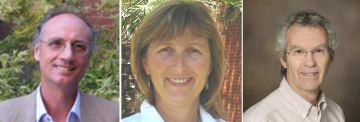
Donato F. Romagnolo, PhD, professor of nutritional sciences and cancer biology, and Ornella I. Selmin, PhD, associate research professor of nutritional sciences, are leading a team of researchers who are investigating how genistein, a component of soy foods, might suppress the development of breast cancer. They’ve found that a particular gene, BRCA1, when functioning properly, keeps DNA stable and protects against genetic diseases like cancer. However, if that gene becomes damaged and is “silenced”, then it is unable to do its job of suppressing tumors.
Genistein comes into play by protecting BRCA1, and when used as a therapeutic treatment can even unsilence an abnormally functioning BRCA1 allowing it to resume its role preventing tumors. Fellow BIO5 member Tom Doetschman, PhD, is a collaborator on the team, providing expertise with genetic models.
Project Investigators:
New Technology Targets Lifespan of Cancer Cells

A new drug aimed at shortening the lifespan of cancer cells has been invented by Dr. Vijay Gokhale, Senior Research Scientist at the BIO5 Institute, and Dr. Laurence Hurley, Associate Director of the BIO5 Institute. This new technology essentially induces cancer cells to get old and die by targeting gene expression, specifically through the creation of a drug that regulates the expression of a protein called telomerase. Similar technologies created in the past which control lifespan have taken several months to exert effect in cancer cells, however this novel invention promotes cell aging and death within days. The drug has been licensed to a new startup called Relegene, also co-founded by Drs. Gokhale and Hurley, with the aid of Tech Launch Arizona.

